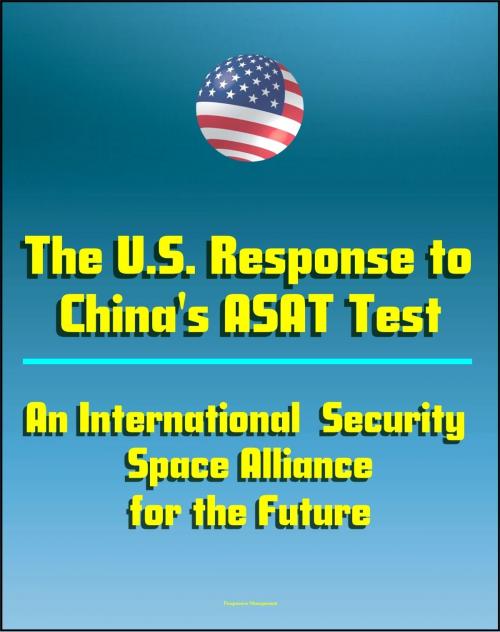The U.S. Response to China's ASAT Test: An International Security Space Alliance for the Future, Anti-Satellite Capabilities and China's Space Weapons Strategy
Nonfiction, Science & Nature, Technology, Aeronautics & Astronautics, Science, Physics, Astrophysics & Space Science| Author: | Progressive Management | ISBN: | 9781476047997 |
| Publisher: | Progressive Management | Publication: | March 23, 2012 |
| Imprint: | Smashwords Edition | Language: | English |
| Author: | Progressive Management |
| ISBN: | 9781476047997 |
| Publisher: | Progressive Management |
| Publication: | March 23, 2012 |
| Imprint: | Smashwords Edition |
| Language: | English |
From the Foreword: (Author) Lt Col Anthony Mastalir has done policy makers a welcome service by exploring the enigma wrapped in a conundrum which is Chinese space policy, focusing on the Chinese kinetic energy antisatellite (KE-ASAT) test of January 2007. That test ended a de facto moratorium on KE-ASAT tests which the United States and Russia had observed for over two decades. It also announced the arrival of a new player in strategic space, forcing a reevaluation of US capabilities in space as well as Chinese intentions there. Colonel Mastalir examines both that reevaluation and those intentions, relying on open-source material, particularly from Chinese strategic and military analysts.
Of chief interest, of course, are the motives of the People's Republic of China (PRC) leadership for demonstrating a technology—kinetic kill of satellites in low-earth orbit—which is so destructive to the common environment of space. This in particular is something PRC spokesmen themselves have never adequately explained. Still, what emerges from the documents the author examines is the picture of an intellectual framework of deterrence strikingly similar to that which the United States developed in the 1950s and thereafter. The fathers of US deterrence strategy—Thomas Schelling, Albert Wohlstetter, and Herman Kahn, among others—would certainly recognize People's Liberation Army (PLA) space strategists as their intellectual heirs. Chinese determination to counter strategic "hegemony" on earth and in space, and the apparent conviction of PLA strategic planners that a robust and demonstrated ASAT capability is necessary to offset what they see as the offensive potential of programs like missile defense, would be instantly recognizable to those US strategists who developed the doctrines of counter-value deterrence, escalation dominance, asymmetric warfare, and assured second-strike capability.
Nor is there anything essentially alien about what the author concludes is China's use of space as a symbol of status in the international community. It is we and the Soviets who made space capability a marker of international prestige, and that tradition continues in the commentaries of those who imagine a reignited race to the Moon and Mars, which the United States must win in order to demonstrate national power and superiority. In short, the Chinese, as they emerge from the public documents the author has relied on, are less inscrutable than we might imagine. On the contrary, they seem to have come to the same conclusions as we that no Great Power can afford not to have a human spaceflight capability, to ignore the military force multiplier effects that space provides, or to discount the possibility of hostilities in space.
This is not a naive study. The author recognizes the potential for hostilities in space and recognizes, too, that a movement in that direction may very well result from decisions over which the United States has little control. But equally, he offers a corrective to the view that what we are facing is a determined and unified opponent. We know that our own policy often results from brokerage among competing bureaucratic and congressional and private interests, that those charged with implementing policy can distort or "slow roll" the clearest executive direction, and that ignorance and personal rivalry can and often do influence decisively the policy outcome. But we tend to impute to our potential opponents cold-blooded rationality and singleness of purpose. Colonel Mastalir avoids this illusion, emphasizing instead the bureaucratic disagreements and lack of communication evident in the PRC documents. One might add that PRC foreign office personnel and other Chinese commentators have been quite open in professing their ignorance of the PLA's motives for the ASAT test—so perhaps Chinese policy making is as opaque to many on the inside as it is to us.
From the Foreword: (Author) Lt Col Anthony Mastalir has done policy makers a welcome service by exploring the enigma wrapped in a conundrum which is Chinese space policy, focusing on the Chinese kinetic energy antisatellite (KE-ASAT) test of January 2007. That test ended a de facto moratorium on KE-ASAT tests which the United States and Russia had observed for over two decades. It also announced the arrival of a new player in strategic space, forcing a reevaluation of US capabilities in space as well as Chinese intentions there. Colonel Mastalir examines both that reevaluation and those intentions, relying on open-source material, particularly from Chinese strategic and military analysts.
Of chief interest, of course, are the motives of the People's Republic of China (PRC) leadership for demonstrating a technology—kinetic kill of satellites in low-earth orbit—which is so destructive to the common environment of space. This in particular is something PRC spokesmen themselves have never adequately explained. Still, what emerges from the documents the author examines is the picture of an intellectual framework of deterrence strikingly similar to that which the United States developed in the 1950s and thereafter. The fathers of US deterrence strategy—Thomas Schelling, Albert Wohlstetter, and Herman Kahn, among others—would certainly recognize People's Liberation Army (PLA) space strategists as their intellectual heirs. Chinese determination to counter strategic "hegemony" on earth and in space, and the apparent conviction of PLA strategic planners that a robust and demonstrated ASAT capability is necessary to offset what they see as the offensive potential of programs like missile defense, would be instantly recognizable to those US strategists who developed the doctrines of counter-value deterrence, escalation dominance, asymmetric warfare, and assured second-strike capability.
Nor is there anything essentially alien about what the author concludes is China's use of space as a symbol of status in the international community. It is we and the Soviets who made space capability a marker of international prestige, and that tradition continues in the commentaries of those who imagine a reignited race to the Moon and Mars, which the United States must win in order to demonstrate national power and superiority. In short, the Chinese, as they emerge from the public documents the author has relied on, are less inscrutable than we might imagine. On the contrary, they seem to have come to the same conclusions as we that no Great Power can afford not to have a human spaceflight capability, to ignore the military force multiplier effects that space provides, or to discount the possibility of hostilities in space.
This is not a naive study. The author recognizes the potential for hostilities in space and recognizes, too, that a movement in that direction may very well result from decisions over which the United States has little control. But equally, he offers a corrective to the view that what we are facing is a determined and unified opponent. We know that our own policy often results from brokerage among competing bureaucratic and congressional and private interests, that those charged with implementing policy can distort or "slow roll" the clearest executive direction, and that ignorance and personal rivalry can and often do influence decisively the policy outcome. But we tend to impute to our potential opponents cold-blooded rationality and singleness of purpose. Colonel Mastalir avoids this illusion, emphasizing instead the bureaucratic disagreements and lack of communication evident in the PRC documents. One might add that PRC foreign office personnel and other Chinese commentators have been quite open in professing their ignorance of the PLA's motives for the ASAT test—so perhaps Chinese policy making is as opaque to many on the inside as it is to us.















